Top News
April 27, 2019 Ryukyu Shimpo
Okinawa Governor Denny Tamaki announced at a regular press conference April 26 that in financial year 2018 (which in Japan ran from April 2018 through March 2019), tourist visitors to the region increased 4.4% (419,000 people) from the previous year to a total of 9,999,000 people.
The figure just barely missed the goal of 10 million visitors, however it did break the record for most visitors in a year, breaking the record set the previous year, as it has for the past 6 years straight. Domestic visitors increased by 1.6% for a total of 6,998,200, also breaking the record for the 6th year straight, and foreign visitors increased 11.5% to 3,000,800, cracking 3 million for the first time.
Governor Tamaki commented, “We did not achieve our goal of 10 million, however the result shows the strength of the Okinawa tourism industry, and was a rewarding year.
To continue this, we want to strengthen our ability to host visitors, and to work towards attracting more to the islands.”
He added that they were working towards a goal of 12 million visitors by 2021.
In March tourist visitors increased year-over-year 5.6% for a total of 884,000, the most ever in March for the region.
Due to things such as typhoons, the tourism totals in July and September decreased compared to the previous year, however with these exceptions every other month saw an increase.
Among domestic visitors, those from the Kansai region decreased 0.8% due to effects such as the temporary closing of Kansai International Airport while Typhoon No. 21 was raging, however overall the favorable market conditions continued.
Visitors from Tokyo increased 1.8% to 3,404,600 with a contribution from the new air route from Narita to Ishigaki Airport, and the direct flight from Nagoya to Naha Airport helped realize an increase of 5.4% to 598,500 visitors.
For foreign visitors, visitors who arrived by sea increased 20.6% to 1,197,100, largely due to cruise ships, breaking 1 million visitors for the first time.
Looking at visitors from abroad by region, visitors from Taiwan accounted for the largest share, increasing 12.9% to 917,700, in part due to the new air route from Kaohsiung International Airport to Naha.
Visitors from mainland China increased 27.3% to 694,800, breaking 600,000 for the first time.
Visitors traveling on routes from Bangkok, Thailand and Singapore also increased.
For 2019, Okinawa is looking to increase domestic visitors by 0.9% to 7.06 million, and to increase foreign visitors by 8% to 3.24 million.
(English translation by T&CT and Sam Grieb)
Go To Japanese

April 26, 2019 Ryukyu Shimpo
On the morning of April 26, the Okinawa Prefectural Assembly (chaired by Yonekichi Shinzato) opened an extraordinary session and unanimously adopted a resolution and written statement protesting the murder of a Japanese woman in Chatan Town by a U.S. Navy sailor assigned to a Marine Corps unit in Okinawa.
The resolution and statement address incidents and accidents due to the presence of U.S. bases, including those caused by known deserters and drunk driving.
The resolution made three requests to the U.S. and Japanese governments: (1) apologize again to the prefectural people and make complete reparations to the bereaved family, (2) take drastic measures to prevent recurrence, and (3) make drastic revisions to the U.S.-Japan Status of Forces Agreement and perform a large-scale consolidation and reduction of U.S. bases.
It also criticizes the U.S. military for loosening the Liberty policy, which regulates the activities of U.S. military personnel such as nighttime outings and drinking off-base, and is holding the U.S. liable for permitting the Navy sailor to go off-base despite a woman he victimized having a restraining order out against him.
Touching on the 2016 incident in which a woman was raped and killed by a civilian in military employ, the resolution points out, “Repeated atrocities have caused Okinawans great distress and shock.”
This protest resolution has been sent to the U.S. Ambassador to Japan and the Commander of the U.S. Forces, Japan, among others.
Additionally, the written statement has been sent to the Prime Minister, the Minister for Foreign Affairs, the Minister of Defense, and others.
(English translation by T&CT and Erin Jones)
Go To Japanese
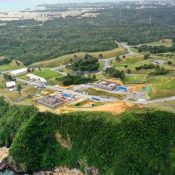
April 24, 2019 Ryukyu Shimpo
Repairs such as reconstruction of buildings are continuing to take place at the U.S. military Henoko ammunition storage facilities in Nago City, Okinawa Prefecture.
The Ryukyu Shimpo took photographs of the site with a drone on April 23 capturing at least two buildings being constructed.
According to the “INTEGRATED NATURAL RESOURCES AND CULTURAL RESOURCES MANAGEMENT PLAN” published by the U.S. Marine Corps in 2014, “Proposed changes for the Henoko Ordnance Ammunition Depot include demolishing 13 magazines and replacing them with 12 non-propagating, wall magazines and a weapons assembly area.
The construction will require significant earth-work and disturbance of undeveloped land.”
Experts point out that there is an active fault near the area between the ammunition storage and the sea area where the new base is to be constructed.
Once the new base is complete, U.S. military aircrafts are to take flight, which would conflict with the “height limit” that the U.S. military indicates for the storage facilities.
A representative of the Okinawa Defense Bureau said, “The construction is to rebuild existing ammunition storage facilities; it is not to add additional functions.”
Meanwhile, Anti-Helicopters and Military Bases Council Joint Representative Hiroshi Ashitomi pointed out that “The U.S. Trump administration has declared to station small nuclear (warheads). In addition to strengthening the base functions, (this rebuilding is) preparing for storing nuclear weapons.”
(English translation by T&CT and Chelsea Ashimine)
Go To Japanese
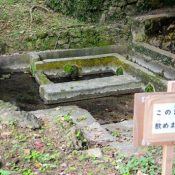
April 24, 2019 Ryukyu Shimpo
By Chie Tome
On April 23 it came to light that a water quality study conducted last year by the Okinawa Prefectural Enterprise Bureau in the vicinity of Kadena Air Base detected high concentrations of perfluorooctane sulfonate (PFOS) and perfluorooctanoic acid (PFOA), which are possible carcinogens, in the spring water near the Hija River intake pump.
This is the first time the Enterprise Bureau has conducted a study of the spring water around Kadena Air Base. The Bureau states that simply touching the water will not have an effect, but advises against drinking it.
Experts have indicated that these results further heighten the possibility that the water contamination originated from the base.

The Enterprise Bureau has informed the Okinawa Prefectural Department of Environmental Affairs and the Kadena Town government of the study results. On April 19, Kadena Town set up three billboards alerting residents about the spring water.
Director Masami Kawamura of the Informed-Public Project (IPP) acquired the water quality study materials from the Enterprise Bureau by requesting disclosure of information.
As part of water quality monitoring, the Bureau has been periodically surveying the areas around some intake pumps since 2014. Starting in April last year the Bureau found a rising concentration of PFOS at the Nagata River intake pump, northwest of the Hija River pump, so it then began studying Hija River’s water and groundwater in that vicinity.
In a study of nine areas of spring and river water surrounding the Hija River intake pump, with testing conducted between May 28 and July 30 on seven occasions last year, the Bureau detected concentrations of PFOS/PFOA of over 1000 nanograms per liter (1000ng/L) at six places including Shiriiga and Ubuga.
PFOS/PFOA have been identified as possible carcinogens.
Although Japan has no domestic environmental standard concerning these chemicals, in the United States the Lifetime Health Advisory Level (HAL) for these chemicals in drinking water is set at 70ng/L.
Professor Yutaka Tashiro of Meio University, who is well-aquainted with environmental studies, said that this data reflects the composition of the groundwater and soil, as well as the state of the environment.
As this is the first study of these circumstances throughout the area to the north and northwest of Kadena Air Base, Professor Tashiro said: “There is a wider scope of groundwater contamination around the base than previously known, and it may be run-off from the base.”
In January this year the Prefectural Environmental Preservation Division also conducted a water quality study of the same site.
The results of the Division’s study, made public on April 23, showed that PFOS/PFOA concentrations of 2100ng/L were detected in Ubuga, and 2000ng/L in the groundwater of Mizugama, Kadena Town.
(English translation by T&CT and Erin Jones)
Go To Japanese

April 28, 2019 Ryukyu Shimpo
Okinawa Governor Denny Tamaki gave a speech at Waseda University in Tokyo April 25, in which he described the situation in Okinawa as, “a situation that continues to be what can only be thought of as anti-democratic.
I want everyone to see the land reclamation at Henoko in Nago City as a reflection of the state of democracy in Japan,” asking the roughly 700 audience members to think about the nature of democracy for each and every citizen.
In his speech he also referenced the killing of a woman in Chatan by a U.S. sailor, and the rape and murder of a woman by an ex-Marine three years prior, saying, “Even though they say they are working to prevent these things from reoccurring and to strengthen discipline, it keeps happening.
The loss of the lives of your fellow citizens is regrettable, and we cannot help but feel fierce anger.
” Tamaki also touched on the U.S. aircraft parts that fell onto the school grounds of a nursery school and an elementary school, and indicated that the actions taken by the Japanese government towards the U.S. in response to these incidents have been weak.
When talking about his first half-year in office, Tamaki reflected, “Half of this job is the base problem. When an unexpected incident occurs, a statement has to be put out as an initial response.
Part of my job as governor has been to tell you all that these security issues are not just an Okinawan problem, but an issue for Japan as a whole.”
Tamaki explained that the Marines were relocated to Okinawa after having originally been stationed on Japan’s main island, and stressed that the burden of Japan-U.S. security treaty was being unevenly distributed to Okinawa, stating, “I want you all to understand that the bases in Okinawa were built by the forceful seizure of land.
The reality of the Japan-U.S. security treaty is not in close by, and therefore it is invisible to you all. The reality of the Japan-U.S. Status of Forces Agreement (SOFA) has been obscured as well.
I want you all to accept these realities.”
Jinshiro Motoyama, the representative from the group that put together the earlier referendum vote regarding base construction in Henoko, also took the state to talk about the effort involved with realizing the vote, saying, “I want you to think about how to spread this information to the people around you.”
(English translation by T&CT and Sam Grieb)
Go To Japanese

April 25, 2019 Ryukyu Shimpo online edition
Tomohiro Yara (independent), who was newly elected to the Lower House Okinawa No. 3 district seat in the by-election on April 21, attended his first Diet session on the morning of April 25.
He said, “Problems in Okinawa are but a symptom of one of this country’s pathologies. I want to properly delve into the problems.”
Yara has entered the Lower House coalition the Democratic Party of Japan and Club of Independents, and belongs to the Lower House Committee on Environment.
(English translation by T&CT and Erin Jones)
Go To Japanese
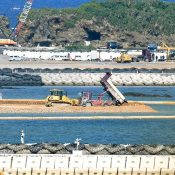
April 23, 2019 Ryukyu Shimpo
On April 22 Okinawa Governor Denny Tamaki submitted materials to the Committee for Settling National-Local Disputes, an entity belonging to the Ministry of Internal Affairs and Communications, requesting a third-party review of Land Minister’s decision to annul the Okinawa Prefectural Government’s (OPG’s) revocation of the land reclamation permit.
In its request for review, the OPG is recommending that the Land Minister’s decision be nullified because the Ministry of Land, Infrastructure, Transport and Tourism (MLIT) is a national entity driving Henoko relocation forward and therefore not an impartial party, so it is illegal for it to make this decision.
The Disputes Committee will make a judgement within 90 days. In an interview at the Prefectural Office, Governor Tamaki said, “For the national government to pose as a private citizen and make use of the system of administrative appeal, forcing follow-through on its own interests, is a breakdown of local autonomy and democracy.
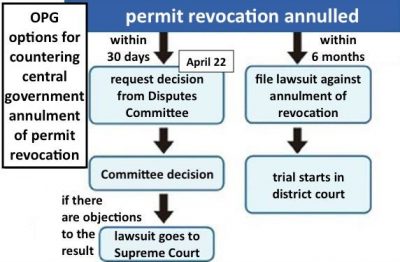
Tomohiro Yara, a candidate opposing construction of the Futenma Replacement Facility (FRF) in Henoko, was elected to the Lower House Okinawa No. 3 district seat on April 21.
This is yet another display of Okinawans’ sentiment opposing MCAS Futenma relocation within Okinawa. Despite Yara’s election, the day following the vote construction on the FRF continued.
In its review request to the Disputes Committee, the OPG brought up several issues including: (1) Because the Okinawa Defense Bureau (ODB) is not in the same position as an average private citizen it cannot make a formal objection to [the OPG’s] revocation through the system of administrative appeal, and the Land Minister cannot make a decision in regard to an illegitimate formal objection, and (2) the Land Minister is one cabinet minister, not in a position to make a decision concerning a claim by the ODB.
Furthermore, the request claims that the Land Minister making the annulment decision as the review authority is a severe absue of power and an illegal act.
Nullifying the annulment decision in regard to the land reclamation permit is intended to restore the legality and validity of the revocation, and once again block land reclamation work.
If the Disputes Committee rejects the request, the OPG is likely to file suit to the Supreme Court based on the Local Autonomy Act in order to nullify the MLIT decision.
Governor Tamaki emphasized in an interview that, “Quickly removing the risk of Futenma [Air Station] with the inevitable lengthening [period] of construction is a difficulty.
We cannot overlook that several matters pointed out by the OPG, such as soft ground, were not taken into account and illegal construction is being performed.
” He went on to say, “I wish for impartial and fair judgement.”
The review request is 71 pages long. It is expected to reach the board of the Committee for Settling National-Local Disputes on April 23.
Also on April 22, in response to the Land Minister’s annulment of the land reclamation permit revocation, the OPG withdrew its lawsuit requesting that the injunction (stay of execution) on the revocation be overturned.
When the Land Minister annulled the revocation on April 5, it had the effect of abolishing the temporary injunction, which acted as a stay of execution on the revocation.
(English translation by T&CT and Erin Jones)
Go To Japanese
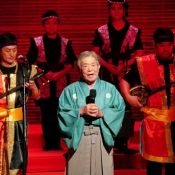
April 20, 2019 Ryukyu Shimpo
By Naoki Isa, New York
The Ryukyu Koten Afuso Ryu Ongaku Kenkyuu Choichi Kai USA (The Afuso School Style of Classical Ryukyu Music Association) and its president, Grant Sadami Murata, presented “TOBE! Uta Sanshin in NY” at the Carnegie Hall in New York City, on the evening of April 18.
The Choichi Kai studies the teachings of Choichi Terukina, 87, who was designated a Living National Treasure for his work in classical Ryukyuan music.
The event celebrated Terukina’s 88th lunar birthday, a milestone in Okinawan culture known as beiju.
According to the Choichi Kai’s USA chapter, it was the first time an Okinawan group performed solo at the legendary Carnegie Hall, showcasing Ryukyuan performance in an ethnically and culturally diverse global metropolis.
Carnegie hall comprises three venues.
Some 120 students from the U.S., Okinawa and Japan performed at the Zankel Hall, which is designed for chamber concerts.
An audience of approximately 400, including Okinawan descendants and New York residents, enjoyed the show.
Terukina opened the show with Chōja nu Ufushu, a traditional wedding dance, with his students in tow.
For the last number, he sang the Shukkee Bushi, accompanied by his students on the sanshin.
The artist said post show, “I am thrilled I got to perform Ryukyuan music in a global city like New York.
The event was a success, thanks in part to the Kenjinkai (Okinawan Association).”
(English translation by T&CT and Monica Shingaki)
To Go Japanese

April 23, 2019 Ryukyu Shimpo
By Yoshinori Takada
There have been countless incidents of problems relating to relationships with and marriages to U.S. military personnel and base workers.
In 2018, 87 people consulted with Women’s Pride, an NPO that provides consultation relating to problems between men and women in international relationships; this is roughly nine times the number of consultations the NPO had in the year it was established.
Some of the cases involved domestic violence and serious situations that could have become life-threatening. “Dating and marrying a member of the military is more difficult than we imagine.
I would like to see [women] enter into relationships with knowledge of the military and good [English] language skills,” says Women’s Pride representative Misaki Smith, 42.
In 2007, when the NPO was established, it received eight in-person consultations and two telephone consultations–a total of 10.
Its work gradually gained recognition, and in 2011 there were 30 consultations.
In the last three years, there have been more than 50 consultations per year just by people living in Okinawa.
Smith says the group is also increasingly sending counselors outside Okinawa to consult with people living in the Kanto area, Nagasaki, and other places where U.S. bases are located.
Smith says that increased use of dating apps and matching apps on smartphones is one factor behind the rise in consultations.
She says there are also malicious cases in which temporarily stationed military personnel return to their home country after getting a woman pregnant.
Divorce, requests for child support, and other procedures involving the military present many difficulties, such as the need to prepare Japanese and English translations of documents.
In cases of domestic violence or other life-threatening situations, it is possible to request that the U.S. military issue a Military Protective Order prohibiting the person in question from contacting or getting near the woman, but Smith says that many women who come to her for consultation are not aware of this.
There are also very few organizations offering consultation services.
“I want people to seek help as soon as there’s a problem,” says Smith.
The group’s homepage is http://okinawawomenspride.blogspot.com.
(English translation by T&CT and Sandi Aritza)
Go To Japanese
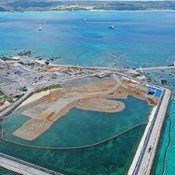
April 20, 2019 Ryukyu Shimpo
A part of the ongoing dispute over new U.S. military base construction in the Henoko neighborhood of Nago, Okinawa, a group of 16 anti-base residents who live in the area where land reclamation work is ongoing just off the coast of Henoko have filed a lawsuit against the Japanese government in the Naha District Court, demanding a ruling by the Minister of Land, Infrastructure, and Transportation that overturned Okinawa’s revocation of the permission to reclaim land, which the citizens group argue is illegal, be itself overturned.
In January, the plaintiffs also filed a suit to undo an executive order issued by the Minister of Land, Infrastructure, and Transportation that nullified the revocation of permission.
On April 5, the Minister of Land, Infrastructure, and Transportation accepted a request for an administrative review by the Okinawa Defense Bureau (ODB), who disagreed with the revocation, and the Minister decided that the revocation was not legal, and ruled in favor of nullifying it. Unlike the previous lawsuit, which questioned the executive order, the suit this time aims to overturn the ruling that preceded it.
The lawsuit in January held their first oral arguments previously, with the second round of arguments set to take place May 23. According to representatives in the suit, they have requested that the court hears the first round of arguments in the new lawsuit be heard at the same time.
In the legal brief, under the Administrative Appeal Act, which was passed to protect the rights and interests of citizens, inherently excludes the ODB, which is a body of the central government, and prohibits them from making use of the law.
It also argues that the Minister of Land, Infrastructure, and Transportation who handed down the ruling, is part of the cabinet that holds a policy that the Henoko relocation is the “only solution,” meaning the Minister is incapable of acting as a neutral third-party arbiter.
(English translation by T&CT and Sam Grieb)
Go To Japanese
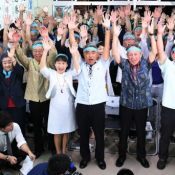
April 21, 2019 Ryukyu Shimpo
Tomohiro Yara, 56, is a freelance journalist and a new independent candidate in the Lower House by-election in the Okinawa No. 3 district backed by the “All Okinawa” camp.
He won in the by-election held on April 21 after Denny Tamaki resigned the seat in his successful bid in the Okinawa gubernatorial race.
The vote was closed at 8:00 p.m. on April 21 and the votes were counted on the same day.
Constituents in the Okinawa No. 3 district chose Yara, a candidate who opposes construction of the new Henoko base.
This means that the prefectural people, who voted similarly in the September gubernatorial election last year and the prefectural referendum held in February this year, have once again expressed no confidence in the Abe administration pushing forward with land reclamation work in Henoko.
Another new candidate, Aiko Shimajiri, 54, also ran for the seat, endorsed by the ruling Liberal Democratic Party as well as the Komei and Ishin parties.
Shimajiri is a former Upper House member who served as Minister of State for Okinawa and Northern Territories Affairs, yet she did not take the seat.
In the race Yara was challenged to overcome his low profile.
He emphasized that he is the successor of Governor Tamaki, which increased support from voters throughout the constituency.
He stressed his opposition to the planned relocation of U.S. Marine Corps Air Station Futenma in Ginowan to Henoko in Nago, which was the main focal point of the race, and called for base-related risk removal by dispersing base facilities to places outside of Okinawa.
Yara promised to block construction of the new Henoko base as an elected Diet member of an Okinawan constituency.
His victory will be a tailwind for the Tamaki prefectural government administration and it has given momentum to the All Okinawa camp, which is working toward the Upper House election in the summer.
In the by-election in the Okinawa No. 3 district, there were fierce debates over several issues including measures to solve children’s poverty problems, the Okinawa Promotion of Special Measures Law as a guideline for the Okinawa promotion, and what the next Okinawa Promotion plan should look like.
(English translation by T&CT)
Go To Japanese












 Webcam(Kokusai Street)
Webcam(Kokusai Street)


